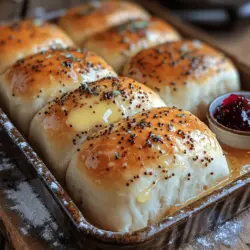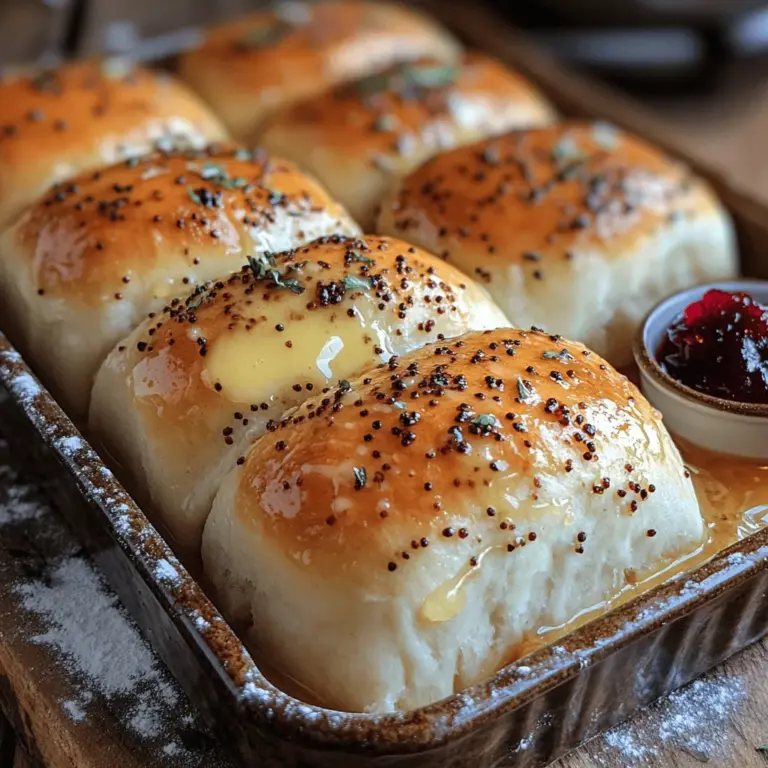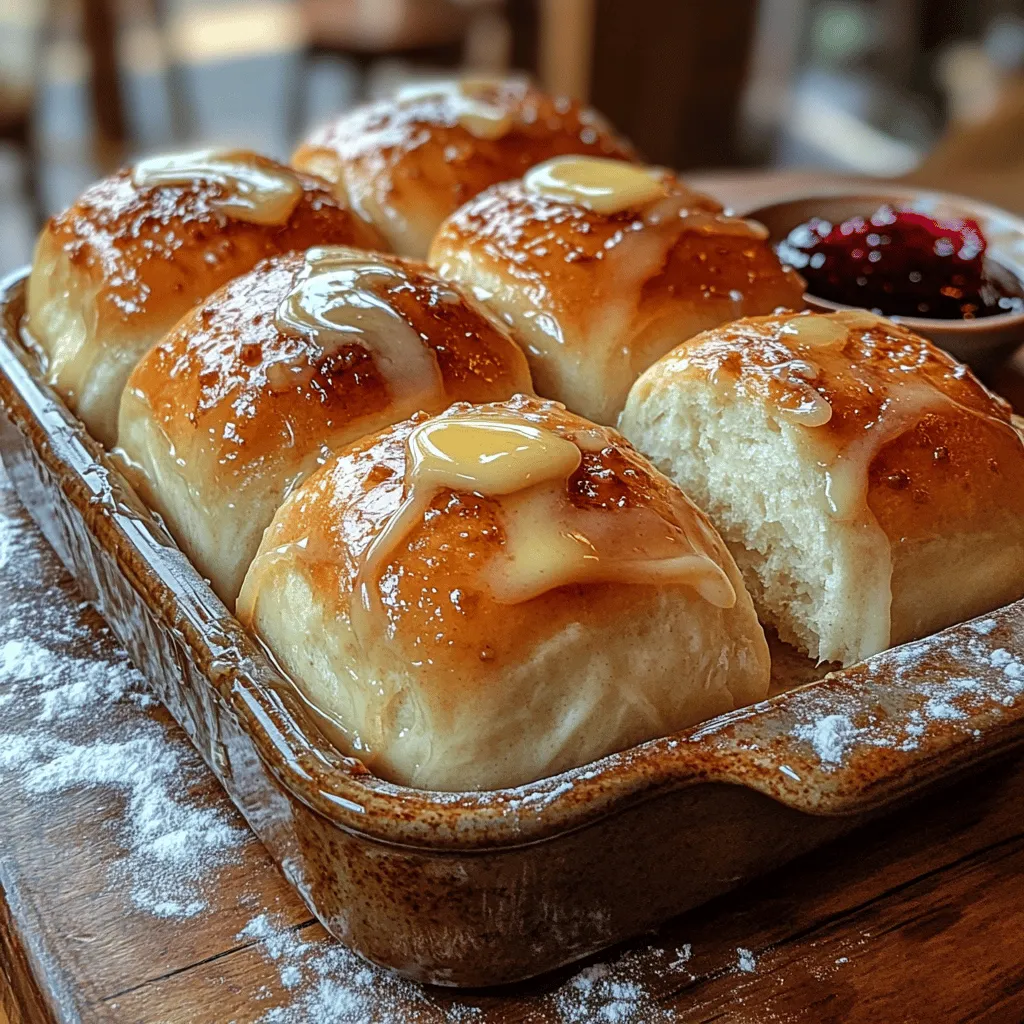Introduction
Parker House Rolls are a beloved classic in American baking, known for their soft, buttery texture and slightly sweet flavor. Originating from the Parker House Hotel in Boston during the 19th century, these rolls have a rich history tied to the evolution of American cuisine. They are often associated with traditional family gatherings, holiday feasts, and special occasions, making them a staple in many households. The story goes that these rolls were created by a baker who was inspired to make a bread that was easy to pull apart, perfect for sharing at the dining table.
The significance of Parker House Rolls goes beyond just their taste; they evoke a sense of nostalgia and comfort, making them an essential addition to any meal. Whether served alongside a hearty stew, as a base for sandwiches, or simply enjoyed with a pat of butter, these rolls are versatile and satisfying. In this article, we will delve into the detailed process of making these exquisite rolls from scratch. Readers can expect to learn about the essential ingredients, preparation techniques, and the step-by-step cooking process that will lead to the perfect batch of Butter Soft Parker House Rolls.
Understanding the Ingredients
To create the best Parker House Rolls, understanding the ingredients is crucial. Each component plays a significant role in achieving that signature soft texture and rich flavor.
Main Ingredients
1. Flour: All-purpose flour is the primary ingredient for these rolls. It provides the structure necessary for the rolls to rise while maintaining a tender crumb. For those looking for an even softer texture, bread flour with a higher protein content can be used, though it may yield a slightly different result.
2. Yeast: Active dry yeast or instant yeast is essential for leavening the dough. Yeast consumes the sugars in the flour, producing carbon dioxide and causing the dough to rise. This is what gives the rolls their lightness and airy quality.
3. Butter: Unsalted butter is a key player in this recipe, contributing to the rolls’ richness and flavor. It is recommended to use high-quality butter, as the taste will shine through in the final product. Some recipes also incorporate a bit of melted butter brushed on top before baking for a golden finish.
4. Milk: Whole milk adds moisture and richness to the dough. It also helps to activate the yeast and contributes to the rolls’ tender texture. If you prefer a dairy-free alternative, unsweetened almond milk or oat milk can be used.
5. Sugar: A small amount of granulated sugar is needed to slightly sweeten the dough and provide food for the yeast during fermentation, promoting a better rise.
6. Salt: Salt is crucial for flavor and also helps to control the fermentation process of the yeast. It enhances the overall taste of the rolls, making them more enjoyable.
Fresh Produce
While Parker House Rolls are not heavily reliant on fresh produce, incorporating herbs can elevate their flavor. For example, fresh rosemary or thyme can be incorporated into the dough for a fragrant twist. These herbs not only add flavor but also a delightful aroma that pairs beautifully with the buttery rolls.
Grains and Starches
The primary grain in Parker House Rolls is wheat, found in all-purpose flour. This grain is the foundation for the rolls, providing necessary gluten structure to achieve that soft, pillowy texture.
Spices and Seasonings
While the traditional Parker House Rolls are kept simple, adding spices or seasonings can enhance the flavor profile. A hint of garlic powder or onion powder can be mixed into the dough for a savory touch. Alternatively, a sprinkle of sea salt on top before baking can provide a pleasing contrast to the sweetness of the rolls.
Importance of Ingredient Quality
The quality of the ingredients used in Parker House Rolls is paramount. Fresh, high-quality ingredients will yield the best results, resulting in rolls that are flavorful and have the perfect texture. For example, using fresh yeast rather than expired yeast can significantly impact the rise of your rolls. Similarly, high-quality butter and milk will impart a richer flavor that enhances the overall experience.
Preparation Steps
Now that we have a solid understanding of the ingredients, let’s move on to the preparation steps. Proper preparation is essential for achieving the best texture and flavor in your Parker House Rolls.
Detailed Preparation Techniques
1. Measuring Ingredients: Accurate measurement is critical in baking. Use a kitchen scale for precise measurements, especially for flour. For volume measurements, spoon the flour into the measuring cup without packing it down and level it off with a straight edge.
2. Chopping and Slicing: If you decide to include fresh herbs or additional flavorings like garlic, chop them finely to distribute their flavor evenly throughout the dough.
3. Mixing the Dough: In a large mixing bowl, combine the flour, sugar, and salt. In a separate bowl, activate the yeast by mixing it with warm milk (between 100°F to 110°F) and a pinch of sugar. Allow it to sit for about 5-10 minutes until foamy. This step verifies that the yeast is active before incorporating it into the dough.
4. Combining Ingredients: Create a well in the center of the dry ingredients and pour in the yeast mixture along with melted butter. Mix until a shaggy dough forms. This can be done by hand or using a stand mixer fitted with a dough hook.
5. Kneading: Transfer the dough to a floured surface and knead for about 8-10 minutes until it becomes smooth and elastic. If using a stand mixer, knead on low speed for about 5-7 minutes. The dough should be slightly tacky but not overly sticky.
Equipment Needed
To make Parker House Rolls efficiently, gather the following equipment:
– Mixing Bowls: A large bowl for mixing the dough and a smaller bowl for activating the yeast.
– Measuring Cups and Spoons: For accurate ingredient measurement.
– Kitchen Scale: Optional but recommended for precision, especially in baking.
– Rolling Pin: To roll out the dough if you wish to shape it into a specific form.
– Baking Sheet: A large, rimmed baking sheet lined with parchment paper for easy transfer of the rolls.
– Plastic Wrap or a Clean Kitchen Towel: For covering the dough during its rise to prevent it from drying out.
– Oven: Preheated to the appropriate temperature for baking.
Essential Kitchen Tools
In addition to the equipment mentioned above, the following kitchen tools will make the process easier:
– Dough Scraper: Useful for handling the sticky dough and transferring it to different surfaces.
– Stand Mixer: While not necessary, it can save time and effort, especially for kneading.
– Pastry Brush: For brushing melted butter over the tops of the rolls before or after baking.
Recommended Cookware for Optimal Cooking Results
Using the right cookware can significantly affect the outcome of your Parker House Rolls. A heavy-duty baking sheet will help distribute heat evenly, ensuring that the rolls bake uniformly. If you have a baking stone, consider placing it in the oven while preheating to create a more consistent baking environment.
Cooking Process
Once the dough is prepared and has risen, it’s time to move on to the cooking process. This is where the magic happens, transforming your ingredients into delicious, fluffy rolls.
Step-by-Step Cooking Instructions
1. First Rise: After kneading the dough, place it in a greased bowl, cover it with plastic wrap or a damp kitchen towel, and let it rise in a warm place until it doubles in size, about 1-1.5 hours.
2. Shaping the Rolls: Once the dough has risen, punch it down to release any air bubbles. Turn it out onto a lightly floured surface. Divide the dough into equal portions, typically about 12-16 pieces, depending on the size of the rolls you desire. Shape each piece into a ball by tucking the edges into the center.
3. Second Rise: Place the shaped rolls on the prepared baking sheet, leaving some space between them as they will rise again. Cover them with a kitchen towel and let them rise for another 30-45 minutes, or until puffy.
4. Preheat the Oven: While the rolls are rising, preheat your oven to 375°F (190°C). This ensures that the rolls will begin baking immediately once placed in the oven.
5. Brushing with Butter: Just before baking, brush the tops of the rolls with melted butter. This step adds flavor and promotes a golden-brown color during baking.
6. Baking: Place the baking sheet in the preheated oven and bake for 15-20 minutes, or until the rolls are golden brown. Keep an eye on them to prevent over-baking, as this can lead to dry rolls.
7. Cooling: Once baked, remove the rolls from the oven and brush them again with melted butter for an extra touch of richness. Allow them to cool for a few minutes before serving.
Cooking Proteins
While Parker House Rolls are often enjoyed on their own, pairing them with proteins can create a complete meal. Whether it’s a succulent roast chicken, tender beef, or a hearty vegetarian dish, the soft rolls serve as a perfect accompaniment.
Sautéing Vegetables
If you’re serving the rolls alongside a vegetable dish, consider sautéing seasonal vegetables such as green beans, carrots, or bell peppers. The timing and technique for perfect doneness involves cooking them in a hot skillet with a small amount of oil, stirring occasionally until tender yet crisp.
Layering Flavors
To achieve the best flavor in your rolls and accompanying dishes, don’t hesitate to layer flavors. Start with a base of aromatic ingredients like onions and garlic, then add herbs and spices to elevate the overall taste. Adjust seasoning throughout the cooking process to ensure a balanced flavor profile.
Adjusting Cooking Times
As you become more familiar with the Parker House Rolls recipe, feel free to experiment with variations. Adjusting cooking times may be necessary based on oven performance and the size of the rolls. For smaller rolls, reduce the baking time slightly, while larger rolls may require a few extra minutes.
Through this process, you will not only create delectable Butter Soft Parker House Rolls but also gain a deeper appreciation for the art of baking. Each step is crucial in achieving the perfect texture and flavor, resulting in rolls that are sure to impress. Stay tuned for the next part, where we will dive deeper into some expert tips and tricks for making these rolls even better.
Variations and Customizations
When it comes to Butter Soft Parker House Rolls, one of the joys of this beloved recipe is its adaptability. Whether you have specific dietary preferences or simply want to experiment, there are numerous variations and customizations you can explore.
Alternative Ingredients for Dietary Preferences
For those with dietary restrictions, consider incorporating alternative ingredients. You can replace conventional all-purpose flour with whole wheat flour to add more fiber and nutrients, though this may yield a denser roll. To maintain the signature softness, you may wish to blend it with bread flour, which has a higher protein content.
Vegetarian and Vegan Substitutions
While traditional Parker House rolls are often made with butter and milk, vegans can easily substitute these ingredients. Use plant-based butter in place of regular butter, and almond, soy, or oat milk instead of dairy milk. Adding a splash of apple cider vinegar to nut milk can create a buttermilk effect that works wonderfully in this recipe.
Gluten-Free Options
For gluten-free adaptations, use a gluten-free all-purpose flour blend that contains xanthan gum. This will help achieve a texture similar to traditional rolls. Many brands offer high-quality blends that mimic the properties of wheat flour, ensuring your rolls remain soft and fluffy.
Regional Variations of the Recipe
Parker House rolls have their roots in Boston, but they are embraced by various cultures, leading to unique regional interpretations. In the Southern United States, for instance, you might find them served with a hint of honey or a dash of cayenne pepper for added flavor. Alternatively, in some European countries, they might be made richer with the addition of eggs, resulting in a slightly denser roll.
Cultural Interpretations and Unique Twists
Cultural variations can also lead to delightful adaptations. For example, in Italian cuisine, you might introduce herbs such as rosemary or thyme into the dough, lending an aromatic flair that complements savory dishes. In Indian cuisine, consider infusing the dough with spices like cumin or coriander for a flavorful twist.
Popular Adaptations in Different Cuisines
In some Asian cuisines, rolls similar to Parker House are crafted with a touch of coconut milk, adding a subtle sweetness and unique flavor profile. You can also experiment by stuffing the rolls with sweet or savory fillings like garlic and cheese, or even chocolate for a dessert version.
Serving Suggestions
Parker House rolls are incredibly versatile and can be enjoyed in various ways. Here are some ideal accompaniments and serving suggestions that will elevate your experience.
Ideal Accompaniments to Enhance the Dish
These rolls are perfect when slathered with softened butter, honey, or jam, enhancing their buttery flavor. Pair them with a rich gravy or creamy soup for a comforting meal.
Side Dishes That Complement the Main Recipe
Parker House rolls pair beautifully with a variety of main dishes. Serve them alongside roasted chicken, beef stew, or a hearty vegetable casserole. They are also an excellent addition to holiday feasts, complementing dishes like turkey and cranberry sauce.
Suggested Beverages
To enhance your meal, consider serving light-bodied wines such as Chardonnay or Pinot Grigio, which will complement the buttery flavor of the rolls. If you prefer cocktails, a refreshing mojito or a gin and tonic can provide a delightful contrast. For a non-alcoholic option, iced tea with a splash of lemon can be a refreshing choice.
Plating Ideas for a Beautiful Presentation
To create an inviting presentation, arrange the rolls in a decorative basket lined with a linen napkin. Alternatively, you can place them on a rustic wooden board, garnished with fresh herbs or edible flowers to add color and texture.
Garnishing Techniques to Elevate the Dish Visually
For a finishing touch, consider brushing the rolls with melted butter immediately after baking for a glossy sheen. Sprinkling coarse sea salt or fresh herbs like parsley or thyme on top adds both flavor and visual appeal.
Nutritional Information
Understanding the nutritional content of your Butter Soft Parker House Rolls can help you enjoy them more mindfully.
Breakdown of Nutritional Content
Each roll typically contains around 150 calories, depending on the size and ingredients. A standard serving size of two rolls can provide approximately 300 calories, 10 grams of fat, 40 grams of carbohydrates, and 5 grams of protein.
Calories, Macronutrients, and Health Benefits
These rolls are a source of carbohydrates, which are essential for energy, especially when served as part of a larger meal. The fats from butter contribute to the satiety factor, making them a satisfying addition to your meal.
Tips for Making the Dish Healthier
To cut down on calories and fat, consider using less butter or substituting some of the butter with applesauce or Greek yogurt. You can also reduce the sugar content slightly without compromising the flavor.
Reducing Fat, Sugar, or Sodium Content
Using whole grain flour can increase the fiber content, making the rolls more filling. Reducing the salt in the recipe can also help make them healthier without sacrificing taste.
Storing and Reheating
Proper storage and reheating techniques are crucial for maintaining the freshness and flavor of your Parker House rolls.
Best Practices for Storing Leftovers
Store any leftover rolls in an airtight container at room temperature for up to two days. If you want to keep them longer, consider freezing them, where they can stay fresh for up to three months.
Containers and Methods for Optimal Freshness
Use a resealable plastic bag or a container with a tight lid to prevent air exposure. Wrapping them in plastic wrap before placing them in a bag can provide an additional layer of protection against drying out.
Reheating Techniques to Maintain Flavor and Texture
To enjoy your rolls warm again, the best method is to reheat them in the oven. Preheat your oven to 350°F (175°C), wrap the rolls in aluminum foil, and heat for about 10 minutes. This will help rejuvenate their soft texture.
Microwave vs. Oven vs. Stovetop Methods
While the microwave is a quicker option, be cautious as it can make the rolls chewy if overheated. If you choose this method, warm them in short bursts of 10-15 seconds, checking frequently. Stovetop reheating is less common but can be done by placing a few rolls in a covered pan on low heat for a few minutes.
Conclusion
Butter Soft Parker House Rolls are a delightful addition to any meal, showcasing a perfect balance of flavor and texture. Their versatility allows for numerous adaptations, making them suitable for various dietary needs and preferences. Whether enjoyed as a side with your favorite dishes, filled with sweet or savory surprises, or simply served warm with a pat of butter, these rolls are sure to impress.
As you embark on making these rolls, don’t hesitate to experiment with different flavors and ingredients. The joy of cooking lies in creativity and sharing the fruits of your labor with loved ones. So gather your ingredients, roll up your sleeves, and enjoy the process of baking these delicious rolls. Your family and friends will appreciate your efforts, and you may just find a new favorite recipe in the process.


